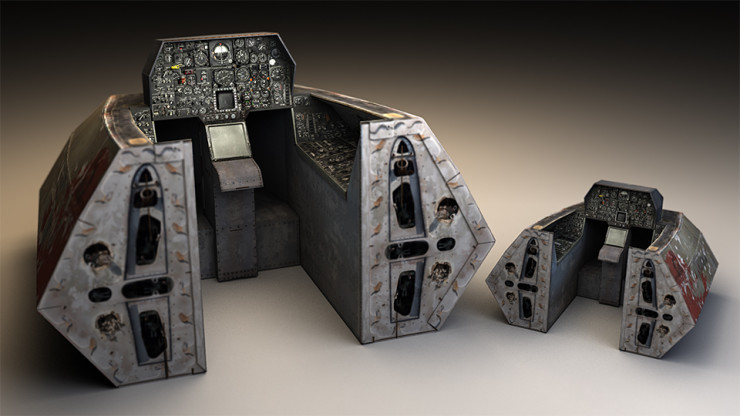Tag Archives: simulations
Cardboard Jet Fighter Cockpit Big Enough To Accommodate Office Chair

Getting work done or playing a sim game in a “real” cockpit, while having both feet firmly planted not the ground, is an ambition of some that usually requires lots of skill or very deep pockets. Dogfight Boss founder Lukas Homola thought he could do things differently, and decided to recreate the cockpit of an F22 fighter jet in an easy-to-asseble cardboard kit. He and a friend went to some aviation museums and took pictures of cockpits to recreate high definition textures for the kits. Since they’re made out of cardboard, it’s easy to cut out holes to fit any “instruments” you might want, like an iPad or a monitor or anything else you like. They’re made out of cardboard ribbing for durability, and all the parts except the center console are simply slid into place and not glue, which makes disassembly a snap.
It’s a $500 pledge for a physical version of the cockpit, though for $48 you can get a print-at-home PDF.
[ Project Page ] VIA [ Technabob ]
The post Cardboard Jet Fighter Cockpit Big Enough To Accommodate Office Chair appeared first on OhGizmo!.
Sandia Labs’ MegaDroid project simulates 300,000 Android phones to fight wireless catastrophes (video)
We've seen some large-scale simulations, including some that couldn't get larger. Simulated cellular networks are still a rare breed, however, which makes Sandia National Laboratories' MegaDroid project all the more important. The project's cluster of off-the-shelf PCs emulates a town of 300,000 Android phones down to their cellular and GPS behavior, all with the aim of tracing the wider effects of natural disasters, hacking attempts and even simple software bugs. Researchers imagine the eventually public tool set being useful not just for app developers, but for the military and mesh network developers -- the kind who'd need to know how their on-the-field networks are running even when local authorities try to shut them down. MegaDroid is still very much an in-progress effort, although Sandia Labs isn't limiting its scope to Android and can see its work as relevant to iOS or any other platform where a ripple in the network can lead to a tidal wave of problems.
Filed under: Cellphones, Wireless, Mobile, Alt, Google
Sandia Labs' MegaDroid project simulates 300,000 Android phones to fight wireless catastrophes (video) originally appeared on Engadget on Wed, 03 Oct 2012 17:24:00 EDT. Please see our terms for use of feeds.
Permalink New York Times |
New York Times |  Sandia National Laboratories | Email this | Comments
Sandia National Laboratories | Email this | Comments Scientists create simulation of the universe, reenact 14 billion years in a few months (video)
Are animations of Curiosity's Mars landing not enough to feed your space exploration appetite? Try this on for size: a group of scientists from the Harvard-Smithsonian Center for Astrophysics and the Heidelberg Institute for Theoretical Studies have generated what's billed as a full-fledged simulation of the universe. Arepo, the software behind the sim, took the observed afterglow of the big bang as its only input and sped things up by 14 billion years. The result was a model of the cosmos peppered with realistically depicted galaxies that look like our own and those around us. Previous programs created unseemly blobs of stars instead of the spiral galaxies that were hoped for because they divided space into cubes of fixed size and shape. Arepo's secret to producing accurate visualizations is its geometry; a grid that moves and flexes to mirror the motions of dark energy, dark matter, gasses and stars. Video playback of the celestial recreation clocks in at just over a minute, but it took Harvard's 1,024-core Odyssey super computer months to churn out. Next on the group's docket is tackling larger portions of the universe at a higher resolution. Head past the jump for the video and full press release, or hit the source links below for the nitty-gritty details in the team's trio of scholarly papers.
Filed under: Science
Scientists create simulation of the universe, reenact 14 billion years in a few months (video) originally appeared on Engadget on Fri, 17 Aug 2012 07:09:00 EDT. Please see our terms for use of feeds.
Permalink PhysOrg |
PhysOrg |  Harvard-Smithsonian Center for Astrophysics, Cornell University Library (1), (2), (3) | Email this | Comments
Harvard-Smithsonian Center for Astrophysics, Cornell University Library (1), (2), (3) | Email this | Comments 
